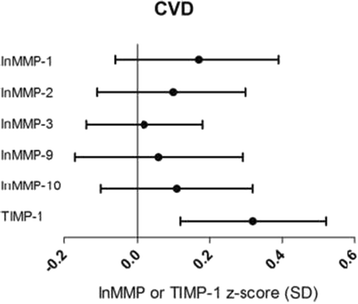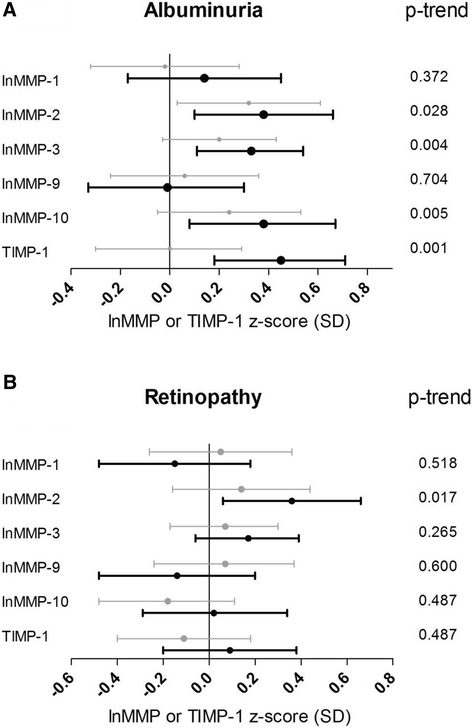Plasma levels of matrix metalloproteinase-2, -3, -10, and tissue inhibitor of metalloproteinase-1 are associated with vascular complications in patients with type 1 diabetes: the EURODIAB Prospective Complications Study
- PMID: 25848912
- PMCID: PMC4355971
- DOI: 10.1186/s12933-015-0195-2
Plasma levels of matrix metalloproteinase-2, -3, -10, and tissue inhibitor of metalloproteinase-1 are associated with vascular complications in patients with type 1 diabetes: the EURODIAB Prospective Complications Study
Erratum in
-
Erratum to: Plasma levels of matrix metalloproteinase-2, -3, -10, and tissue inhibitor of metalloproteinase-1 are associated with vascular complications in patients with type 1 diabetes: the EURODIAB Prospective Complications Study.Cardiovasc Diabetol. 2015 Sep 28;14:128. doi: 10.1186/s12933-015-0290-4. Cardiovasc Diabetol. 2015. PMID: 26415611 Free PMC article. No abstract available.
Abstract
Background: Impaired regulation of extracellular matrix remodeling by matrix metalloproteinases (MMPs) and tissue inhibitor of metalloproteinase (TIMP) may contribute to vascular complications in patients with type 1 diabetes. We investigated associations between plasma MMP-1, -2, -3, -9, -10 and TIMP-1, and cardiovascular disease (CVD) or microvascular complications in type 1 diabetic patients. We also evaluated to which extent these associations could be explained by low-grade inflammation (LGI) or endothelial dysfunction (ED).
Methods: 493 type 1 diabetes patients (39.5 ± 9.9 years old, 51% men) from the EURODIAB Prospective Complications Study were included. Linear regression analysis was applied to investigate differences in plasma levels of MMP-1, -2, -3, -9, -10, and TIMP-1 between patients with and without CVD, albuminuria or retinopathy. All analyses were adjusted for age, sex, duration of diabetes, Hba1c and additionally for other cardiovascular risk factors including LGI and ED.
Results: Patients with CVD (n = 118) showed significantly higher levels of TIMP-1 [β = 0.32 SD (95%CI: 0.12; 0.52)], but not of MMPs, than patients without CVD (n = 375). Higher plasma levels of MMP-2, MMP-3, MMP-10 and TIMP-1 were associated with higher levels of albuminuria (p-trends were 0.028, 0.004, 0.005 and 0.001, respectively). Severity of retinopathy was significantly associated with higher levels of MMP-2 (p-trend = 0.017). These associations remained significant after further adjustment for markers of LGI and ED.
Conclusions: These data support the hypothesis that impaired regulation of matrix remodeling by actions of MMP-2, -3 and-10 and TIMP-1 contributes to the pathogenesis of vascular complications in type 1 diabetes.
Figures


References
-
- Soedamah-Muthu SS, Fuller JH, Mulnier HE, Raleigh VS, Lawrenson RA, Colhoun HM. High risk of cardiovascular disease in patients with type 1 diabetes in the U.K.: a cohort study using the general practice research database. Diabetes Care. 2006;29:798–804. doi: 10.2337/diacare.29.04.06.dc05-1433. - DOI - PubMed
-
- Galis ZS, Khatri JJ. Matrix metalloproteinases in vascular remodeling and atherogenesis: the good, the bad, and the ugly. Circ Res. 2002;90:251–62. - PubMed
Publication types
MeSH terms
Substances
Grants and funding
LinkOut - more resources
Full Text Sources
Other Literature Sources
Medical
Research Materials
Miscellaneous

